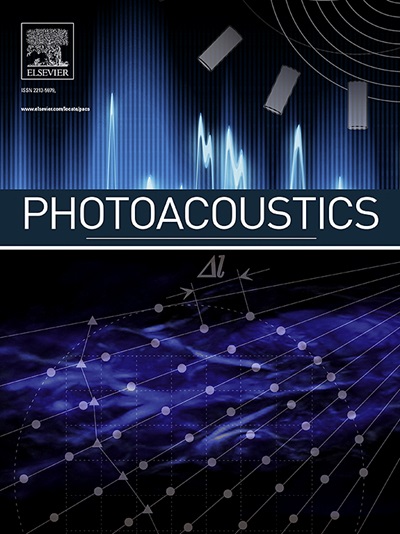基于切比雪夫有理分数阶滤波算法的多变量耦合增强光声光谱检测痕量甲烷
IF 6.8
1区 医学
Q1 ENGINEERING, BIOMEDICAL
引用次数: 0
摘要
为了实现超灵敏的痕量CH4检测,研制了一种基于多变量耦合放大光声电池(MVCA-PAC)的新型微型光声光谱(PAS)气体传感器,其总长度为100 mm。声压分布仿真结果表明,在一阶共振频率下,MVCA-PAC的最大声压比传统光声电池高约3.9倍。通过22次反射,MVCA-PAC的吸收光程达到2068 mm,与具有等效吸收光程的传统光声电池相比,光声信号的振幅增加了2倍。此外,与单通道光声电池相比,MVCA-PAC的2-f信号强度增加了4.5倍。Allan方差分析表明,CH4的检出限为0.572 ppm,平均时间约为300 s。为了进一步提高所设计传感器的测量精度,首次将切比雪夫有理分数阶滤波(CRFOF)算法引入到PAS信号处理中。后处理结果显示测量精度提高了15.4倍,达到0.578 ppm的精度。最后,通过48小时的大气CH4连续监测,验证了该传感器的可靠性和可行性。本文章由计算机程序翻译,如有差异,请以英文原文为准。
Multivariate-coupled-enhanced photoacoustic spectroscopy with Chebyshev rational fractional-order filtering algorithm for trace CH4 detection
An innovative and miniature photoacoustic spectroscopy (PAS) gas sensor based on a multivariate-coupled amplification photoacoustic cell (MVCA-PAC) with a total length of 100 mm was developed to achieve ultra-sensitive trace CH4 detection. Acoustic pressure distribution simulations reveal that at the first-order resonance frequency, the MVCA-PAC achieves a maximum acoustic pressure approximately 3.9 times higher than that of a conventional photoacoustic cell. The absorption optical path of the MVCA-PAC reached 2068 mm through 22 reflections, resulting in a 2-fold increase in the amplitude of photoacoustic signals compared to the traditional photoacoustic cell with an equivalent absorption optical path. Furthermore, compared to a single-pass photoacoustic cell, the 2-f signal intensity of the MVCA-PAC increased by a factor of 4.5. Allan variance analysis indicated a detection limit of 0.572 ppm for CH4 detection with an averaging time of approximately 300 s. To further improve the measurement precision of the designed sensor, the Chebyshev rational fractional-order filtering (CRFOF) algorithm was introduced for PAS signal processing for the first time. Post-processing results demonstrated a 15.4-fold improvement in measurement precision, achieving a precision of 0.578 ppm. Finally, continuous monitoring of atmospheric CH4 over a 48-hour period validated the reliability and feasibility of the sensor.
求助全文
通过发布文献求助,成功后即可免费获取论文全文。
去求助
来源期刊

Photoacoustics
Physics and Astronomy-Atomic and Molecular Physics, and Optics
CiteScore
11.40
自引率
16.50%
发文量
96
审稿时长
53 days
期刊介绍:
The open access Photoacoustics journal (PACS) aims to publish original research and review contributions in the field of photoacoustics-optoacoustics-thermoacoustics. This field utilizes acoustical and ultrasonic phenomena excited by electromagnetic radiation for the detection, visualization, and characterization of various materials and biological tissues, including living organisms.
Recent advancements in laser technologies, ultrasound detection approaches, inverse theory, and fast reconstruction algorithms have greatly supported the rapid progress in this field. The unique contrast provided by molecular absorption in photoacoustic-optoacoustic-thermoacoustic methods has allowed for addressing unmet biological and medical needs such as pre-clinical research, clinical imaging of vasculature, tissue and disease physiology, drug efficacy, surgery guidance, and therapy monitoring.
Applications of this field encompass a wide range of medical imaging and sensing applications, including cancer, vascular diseases, brain neurophysiology, ophthalmology, and diabetes. Moreover, photoacoustics-optoacoustics-thermoacoustics is a multidisciplinary field, with contributions from chemistry and nanotechnology, where novel materials such as biodegradable nanoparticles, organic dyes, targeted agents, theranostic probes, and genetically expressed markers are being actively developed.
These advanced materials have significantly improved the signal-to-noise ratio and tissue contrast in photoacoustic methods.
 求助内容:
求助内容: 应助结果提醒方式:
应助结果提醒方式:


